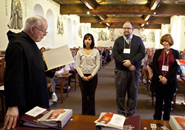The Latin words lectio divina, which mean "divine reading" or "spiritual reading," refer to the slow, meditative reading of a passage from Scripture. It is a form of prayer that focuses on listening and responding to God's word.
Lectio divina is traditionally characterized by four movements: lectio (reading), meditatio(meditation), oratio (prayer), and contemplatio (contemplation).
Four Steps
There is no standard way of doing lectio divina, but the following method has proven helpful to beginners.
-
Read (Lectio): Read a passage from Scripture. "Listen" to God's word. Gather the facts. Does a particular word or phrase speak to you?
-
Reflect (Meditatio): Read the passage again. Reflect on the passage as a whole or on a particular phrase. What is God saying to you?
-
Respond (Oratio): Read the Scripture once again. Respond to God with your heart. What do you want to say to God?
-
Rest (Contemplatio*): Read the selection a final time. Rest in God's presence for a few minutes.
* Strictly speaking, contemplation is a gift of grace that depends on the movement of the Holy Spirit. It is a real awareness of God, desiring and loving Him, beyond concepts, feelings and particular acts.
Further Reading
Sacred Reading: The Ancient Art of Lectio Divina by Michael Casey, OCSO, Liguori Publications, 1997.
"Accepting the Embrace of God: The Ancient Art of Lectio Divina" by Luke Dysinger, OSB. You can read or download the article here.
Praying Scripture for a Change: An Introduction to Lectio Divina by Dr. Tim Gray, Ascension Press, 2009.

Oblates are affiliated with a monastery and are bonded in prayer, love and commitment. They are partners in the prayer and works of the monastery.
Learn More